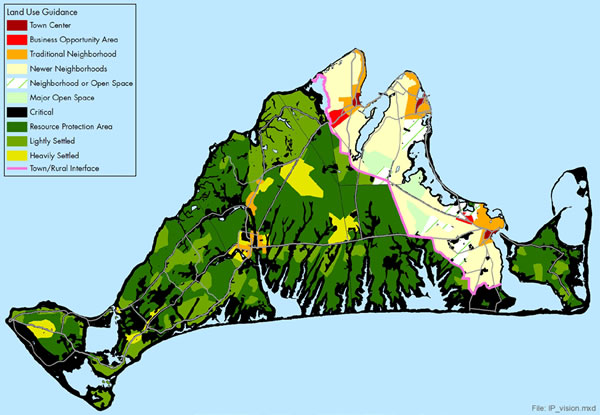
- Introduction: This section looks at the eighteen main challenges facing the community, outlines the main goals of the plan, and highlights the need to act soon to deal with these challenges and reach the goals.
- Development and Growth: This section outlines and evaluates a series of growth scenarios, using extensive build-out analysis and other data to analyze the impacts of each option. It then outlines strategies to moderate and better manage growth by shifting development into smart-growth, mixed-use areas close to town centers and transportation options, by better protecting environmentally sensitive areas., and by preserving the character of the Vineyard. This will require a variety of strategies: new zoning rules, revised thresholds and criteria for MVC project review, carefully targeted open space acquisition, and other tools to ensure that the development that does take place fits well with its surroundings.
- Natural Environment: This section recommends stepping up the pace of open space protection, doubling the acreage of native habitat in sensitive environmental regions, and restoring compromised areas. It proposes to create greenway corridors spanning the length and breadth of the Vineyard, to expand the Island-wide trail network and shoreline access, to protect scenic vistas and roadways, and to grow more food locally to meet a greater portion of our year-round needs.
- Built Environment: This section recommends measures to reinforce neighborhoods and streetscapes, encouraging infill and protecting historic resources while promoting green building practices.
- Social Environment: This section addresses changing age and ethnic demographics, health care, healthy lifestyle choices, and efforts in education and the arts to reflect and amplify our heritage and prepare us for the future. It recommends improved coordination among institutions and town boards, and suggests an organizational structure to better address Island-wide public health issues.
- Livelihood and Commerce: This section proposes strengthening traditional vacation-related industries – hospitality, retail, construction, real estate – while simultaneously moving to a more balanced and diverse, year-round economy that offers higher paying jobs and more opportunities for people who grow up here to stay or return. This means reducing the dollars that “leak” off-Island (instead of re-circulating within the Island community) by supporting local businesses that provide good year-round jobs.
- Energy and Waste: This section proposes to cut projected energy consumption in half by reducing the energy used in our buildings – requiring energy-efficient new construction and encouraging improved energy efficiency in existing buildings – and in transportation. It then proposes generating or offsetting that consumption from renewable sources, notably wind power. It also recommends more sustainable solid waste management, reclaiming reusable materials, reducing waste transportation costs, creating new economic opportunities, and even producing some energy.
- Housing: This section recommends redoubling efforts to create and finance income-restricted housing until 20% of the year-round housing stock is permanently affordable to people earning less than 150% of the area’s median income. The Island Plan outlines strategies for adding hundreds of housing units at prices residents can afford, such as allowing accessory units and higher density construction in certain areas provided the extra units are affordable, and creating incentives to convert existing seasonal rental housing to year-round rentals. The plan also includes proposals for addressing the special needs of the rapidly growing senior population as well as housing for the influx of seasonal workers.
- Transportation: This section proposes making a few modest improvements to our road network, while carefully protecting the two-lane rural roads so essential to the Island’s character. The emphasis is on promoting alternate modes of travel so the island is less dependent on private automobiles. This is particularly challenging here due to the low-density, rural development of much of the Vineyard. The plan proposes to expand and improve the bus system and taxis and promote them as viable ways to get around the Island, to make it easier and safer to use bicycles and to walk.
- Water Resources: The plan proposes to protect coastal ponds and drinking water sources, recognizing that this will require a major public effort and significant investment. A key action will be to expand the use of public sewers or install small-scale neighborhood treatment facilities in high-density areas. This section also proposes to limit growth in sensitive watersheds, to strengthen regulations to protect private wells, and to take action to keep contaminated stormwater from entering critical water resources.
- Implementation: The final section discusses how to turn the Island Plan vision into reality. For each of the 207 strategies, it looks at the type, timing, cost, and responsible entities, and discusses ongoing roles for an Island Plan implementation committee and the MVC. It discusses how to alter the way development is regulated on Martha’s Vineyard, and looks at how the Vineyard community can use indicators to monitor ongoing progress in implementing the Island Plan.

